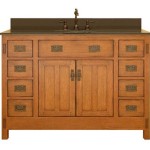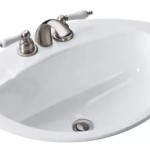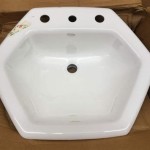36 Inch Undermount Bathroom Sink: A Comprehensive Guide
The 36-inch undermount bathroom sink is a popular choice for homeowners seeking a balance between functionality and aesthetics in their bathroom design. This size offers ample basin space while remaining manageable for most standard-sized vanities. The undermount installation further enhances its appeal by creating a seamless transition between the countertop and the sink, contributing to a cleaner and more modern look. This article delves into the various aspects of a 36-inch undermount bathroom sink, examining its benefits, materials, installation considerations, and factors to consider when making a purchase.
Benefits of Choosing a 36 Inch Undermount Bathroom Sink
One of the primary advantages of a 36-inch undermount bathroom sink is its spaciousness. Compared to smaller options, it provides a larger basin for washing hands, face, or even rinsing small items. This added space is particularly beneficial in master bathrooms or shared bathrooms where multiple users may need access to the sink simultaneously.
The undermount design offers several practical benefits. It eliminates the lip or rim that is present in top-mount or drop-in sinks, making it easier to wipe water and debris directly from the countertop into the sink. This simplifies cleaning and maintenance, reducing the risk of grime buildup around the edges of the sink.
Aesthetically, undermount sinks contribute to a more streamlined and contemporary design. The seamless integration with the countertop creates a clean, uncluttered look. The absence of a visible rim allows the countertop material to be the focal point, showcasing its beauty and texture. This is particularly appealing when using high-end countertop materials like granite, quartz, or marble.
Furthermore, undermount sinks often allow for greater flexibility in countertop design. Because the sink is installed beneath the countertop, the edge profile can be customized to achieve the desired look, ranging from rounded edges to sharp, square profiles. This level of customization is often limited with top-mount sinks.
Material Options for 36 Inch Undermount Bathroom Sinks
The material of a 36-inch undermount bathroom sink significantly impacts its durability, aesthetics, and maintenance requirements. Several popular material options are available, each with its unique characteristics.
Porcelain: Porcelain is a classic choice for bathroom sinks due to its durability, affordability, and stain resistance. It is a non-porous material that is easy to clean and maintain. Porcelain sinks are typically available in white or off-white, providing a clean and timeless look. However, porcelain can chip or crack if subjected to heavy impact.
Ceramic: Ceramic is another common material, often used interchangeably with porcelain. While both are clay-based materials fired at high temperatures, ceramic can sometimes be slightly less durable than porcelain. However, it still offers good resistance to stains and scratches and is generally a cost-effective option.
Fireclay: Fireclay is a type of ceramic that is fired at extremely high temperatures, resulting in a very durable and non-porous material. Fireclay sinks are known for their resistance to chipping, cracking, and staining. They often have a thicker and more substantial feel compared to standard porcelain or ceramic sinks. While more expensive than porcelain or ceramic, fireclay offers superior durability and a luxurious aesthetic.
Stainless Steel: Stainless steel is a popular choice for modern bathrooms due to its sleek appearance and durability. Stainless steel sinks are resistant to rust, corrosion, and stains. They are also relatively easy to clean and maintain. However, stainless steel can be prone to scratches and water spots. The gauge of the steel is an important factor to consider, with lower gauge numbers indicating thicker and more durable steel.
Stone: Natural stone, such as granite, marble, or travertine, can be used to create stunning and unique undermount bathroom sinks. Stone sinks offer a luxurious and natural look, with variations in color and veining that make each sink one-of-a-kind. However, stone is a porous material that requires regular sealing to prevent staining and water damage. Stone sinks are also generally more expensive and require more careful handling during installation.
Cast Iron with Enamel Coating: These sinks offer excellent durability and heat retention, often featuring a glossy, chip-resistant enamel coating in various colors. However, they are heavy and can require reinforced countertop support.
Installation Considerations for a 36 Inch Undermount Bathroom Sink
Proper installation is crucial for ensuring the longevity and performance of a 36-inch undermount bathroom sink. Unlike drop-in sinks, undermount sinks require professional installation, particularly when dealing with countertop materials like granite or quartz.
Countertop Preparation: The countertop must be precisely cut to accommodate the undermount sink. This requires specialized tools and expertise to avoid chipping or cracking the countertop material. The cut should be slightly smaller than the outer dimensions of the sink to allow for a secure and seamless fit. A professional fabricator typically handles this aspect of the installation.
Support and Mounting: Undermount sinks are typically attached to the underside of the countertop using clips, adhesive, or a combination of both. The countertop must provide adequate support for the weight of the sink, especially when filled with water. For heavier sinks, such as those made of cast iron or stone, additional support may be necessary in the form of bracing or a sink support frame.
Plumbing Connections: The drain and water supply lines must be properly connected to the sink and faucet. This involves installing a drain assembly, connecting the water supply lines to the faucet, and ensuring that all connections are leak-free. Plumbers tape or sealant should be used to prevent leaks at threaded connections.
Sealing: A bead of sealant, typically silicone caulk, is applied around the perimeter of the sink where it meets the countertop. This seals the gap between the sink and the countertop, preventing water from seeping underneath and causing damage. The sealant should be smooth and consistent for a clean and professional finish.
Accessibility: Consider the accessibility needs of the users when determining the height of the vanity and sink. The Americans with Disabilities Act (ADA) provides guidelines for accessible bathroom design, including recommendations for sink height and knee clearance. Adhering to these guidelines ensures that the sink is usable by individuals with disabilities.
Vanity Compatibility: Ensure that the 36-inch sink is compatible with the vanity cabinet. This includes checking the dimensions of the sink and the available space within the vanity. Sufficient space is needed for the sink, plumbing connections, and storage within the vanity cabinet.
Factors to Consider When Purchasing a 36 Inch Undermount Bathroom Sink
Choosing the right 36-inch Undermount bathroom sink involves careful consideration of several factors to ensure that it meets the specific needs and preferences of the homeowner.
Budget: The price of a 36-inch undermount bathroom sink can vary widely depending on the material, brand, and features. It is essential to establish a budget before starting the shopping process and to consider the overall cost of the sink, installation, and any necessary accessories.
Style: The style of the sink should complement the overall aesthetic of the bathroom. Consider the shape, color, and design details of the sink to ensure that it blends seamlessly with the other fixtures and finishes in the room. Some popular styles include rectangular, oval, round, and square sinks.
Basin Depth: The depth of the sink basin is an important factor to consider based on usage habits. A deeper basin is better suited for tasks such as washing clothes or filling buckets, while a shallower basin may be preferred for everyday handwashing. Consider how the sink will be used most often to determine the appropriate basin depth.
Overflow Drain: An overflow drain is a small hole located near the top of the sink basin. It prevents water from overflowing in the event that the drain is blocked. While not essential, an overflow drain can provide added peace of mind and prevent potential water damage.
Number of Faucet Holes: The number of faucet holes in the sink dictates the type of faucet that can be installed. Sinks with one hole are designed for single-handle faucets, while sinks with three holes are designed for widespread or center-set faucets. Choose a sink with the appropriate number of faucet holes to match the desired faucet style.
Brand Reputation: Choosing a sink from a reputable brand can provide assurance of quality and durability. Research different brands and read reviews to determine which ones have a track record of producing reliable and well-designed sinks.
Warranty: Check the warranty offered by the manufacturer. A longer warranty period indicates greater confidence in the product's durability and provides protection against potential defects. Understand the terms and conditions of the warranty before making a purchase.
Maintenance Requirements: Consider the maintenance requirements of the sink material. Some materials, such as natural stone, require regular sealing to prevent staining, while others, such as stainless steel, require special cleaning products to prevent water spots. Choose a material that is easy to clean and maintain based on personal preferences and lifestyle.
By carefully considering these factors, homeowners can select a 36-inch undermount bathroom sink that not only meets their functional needs but also enhances the beauty and value of their bathroom.

Cora 36 Inch Single Bathroom Vanity Vintage Tub Bath

Cora 36 Inch Blue Wood Single Bathroom Sink Vanity Vtb

ᐅ Sydney 36 Bathroom Vanity With Engineered Marble White Carrara Color Top 8 Faucet Holes Rectangle Undermount Sink 2 Soft Closing Doors And Full Extension Dovetail Drawers Two On The Right Woodbridge

36 Noxon Vanity For Rectangular Undermount Sink White

Allen Roth Harwood 36 In Natural Undermount Single Sink Bathroom Vanity With White And Gray Quartz Top The Vanities Tops Department At Com

Allen Roth Reo 36 In White Undermount Single Sink Bathroom Vanity With Engineered Stone Top The Vanities Tops Department At Com

Wexler 36 Inch Solid Oak Bathroom Vanity With Undermount Sink

36 Inch Hotel Bathroom Design Quartz Vanity Top With Undermount Sink China Solid Surface Made In Com

Mason Hill 36 Inch Oak Vanity With Oval Undermount Sink Dark

ᐅ Woodbridge London 36 Bathroom Vanity With Engineered Marble White Carrara Color Top 8 Faucet Holes Rectangle Undermount Sink 2 Soft Closing Doors And 3 Full Extension Dovetail Drawers On The Right







